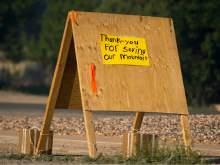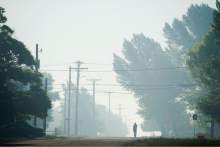This is an archived article that was published on sltrib.com in 2017, and information in the article may be outdated. It is provided only for personal research purposes and may not be reprinted.
Southern Utah's Brian Head Fire is burning so hot, the chemicals that would typically create elevated levels of ozone around the blaze are being completely consumed.
The upside of the conditions of this particular fire, said Kristy Weber, a meteorologist for the Utah Division of Air Quality, is that it's having a limited impact on air quality in Utah's metropolitan areas.
Winds in the area have kept smoke from spreading too far from the fire's immediate vicinity, said Charlotte Dewey, a meteorologist in the National Weather Service's Salt Lake City offices. It's been breezy in the afternoons, she said, so smoke is drifting toward Bryce Canyon, Escalante and Lake Powell. Some might reach Zion National Park and perhaps the four corners area, she said.
What wind is present is blowing the smoke southeast, away from the Wasatch Front. Because the wind is not particularly strong, Mike Conger, another meteorologist with the NSW, said some of the smoke may drift back to nearby cities such as Cedar City and St. George. However, the bulk of the smoke, which is quite thick, remains concentrated primarily around the fire, with a less-defined plume drifting to the east toward Colorado, he said.
The Division of Air Quality doesn't have air monitors in the vicinity of the fire. But Weber said that based on radar and satellite imagery, Brian Head experienced a "red" air day on Friday — meaning levels of small particulate in the smoke are so concentrated that the air is unhealthy for anyone, with or without respiratory conditions, to breathe.
But the smoke is so thick, she said, that it's blocking a lot of the sunlight that would be necessary to kick off the chemical reactions that create ozone pollution. And because of the fire's high temperatures, it's not emitting the chemicals that form ozone, so she said there is little risk that the blaze will cause ozone to accumulate around the its edges. Ozone, which can cause permanent lung damage in high concentrations, can be associated with large wildfires because the burning wood may release the pollutant's precursor chemicals.
But Weber said she would still advise those with respiratory conditions or those who are elderly to avoid the areas directly southeast of the fire. The particulate matter in the smoke could cause people to experience difficulty breathing.
And, she said, if the smoke is thick enough to cause health problems, "you're probably too close to the fire anyway."
Dewey also advised vacationers to check ahead for park or road closures in the fire's wake.
"I would check early before you head out so you don't get here and realize it's closed," she said.
Unfortunately, she said, Utah isn't likely to get any rain to help fight the fire in the near future. But on Monday, she said, it's possible the area's winds could shift, which could push smoke from the fire farther north.
The fire is large enough, Weber said, that with a significant change in the wind, smoke could make its way to the Wasatch Front.
Twitter: @EmaPen





